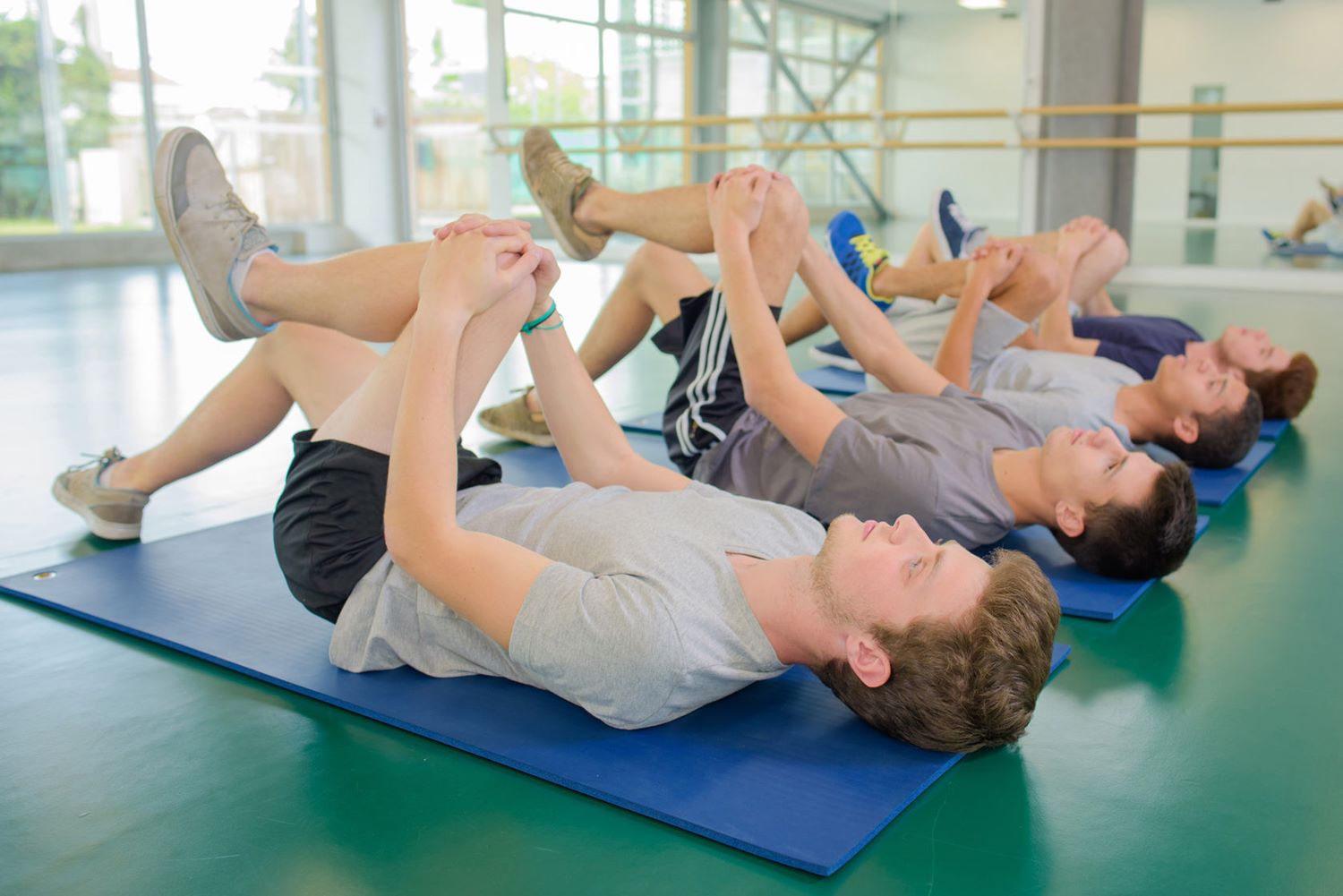

Featured
What Exercise Is Good For Sciatica
Published: October 1, 2023
Looking for featured exercises to alleviate sciatica? Learn what exercise is good for sciatica and find relief from your symptoms today.
Introduction
Welcome to this comprehensive guide on exercises that are good for sciatica. Sciatica is a common condition characterized by pain radiating along the sciatic nerve, which runs from the lower back, down through the buttocks, and into the legs. This pain can be debilitating, affecting daily activities and overall quality of life. However, there is good news – exercise can play a crucial role in managing and alleviating the symptoms of sciatica.
Before diving into the specific exercises, it’s important to understand the nature of sciatica. The sciatic nerve is the longest nerve in the body, and when it becomes compressed or irritated, it can cause pain, numbness, and tingling sensations in the lower back, buttocks, and legs. The most common cause of sciatica is a herniated disc, in which the soft, gel-like material inside the disc protrudes and presses against the nerve.
While the pain associated with sciatica can be intense and persistent, exercise can be an effective non-invasive treatment method. Exercise helps to strengthen the muscles supporting the spine, increases flexibility, improves posture, and promotes overall spinal health. It can also reduce inflammation, increase blood flow, and release endorphins, which act as natural pain relievers.
Engaging in the right types of exercises can bring immense relief to individuals suffering from sciatica. These exercises should be gentle, low-impact, and specifically designed to target the muscles and structures that support the spine. It is important to note that before starting any exercise regimen for sciatica, it is advisable to consult with a healthcare professional or a qualified physical therapist to ensure that you are doing the exercises correctly and safely.
In this article, we will explore the benefits of exercise for sciatica and provide a selection of the best exercises to help alleviate pain and improve overall well-being. So, let’s get started on your journey towards finding relief from sciatica through exercise!
Understanding Sciatica
Sciatica is a condition that affects millions of people worldwide. It is important to have a clear understanding of what sciatica is in order to effectively manage and treat it. Sciatica refers to the pain that radiates along the path of the sciatic nerve, which starts in the lower back and extends down through the buttocks and into the legs. The pain is usually felt on one side of the body and can vary in intensity, from a mild ache to a sharp, shooting pain.
The most common cause of sciatica is a herniated disc, also known as a slipped disc or disc protrusion. When a disc in the spine becomes herniated, the soft inner material of the disc leaks out and presses against the nearby nerves, including the sciatic nerve. This compression or irritation of the nerve can lead to the characteristic symptoms of sciatica.
Other potential causes of sciatica include spinal stenosis, a condition where the spinal canal narrows, putting pressure on the nerves; spondylolisthesis, a condition where the vertebrae slip out of their normal position; and piriformis syndrome, in which the piriformis muscle, located in the buttocks, compresses the sciatic nerve.
The symptoms of sciatica can vary from person to person, but commonly include:
- Sharp or shooting pain in the lower back, buttocks, and legs
- Numbness or tingling sensations in the affected area
- Weakened muscles or difficulty moving the leg or foot
- Worsening pain with prolonged sitting or standing
It’s worth noting that while sciatica often only affects one side of the body, it can also manifest in both legs. The pain may worsen with certain activities, such as coughing, sneezing, or straining, which increase the pressure on the sciatic nerve.
Understanding the underlying causes of sciatica is crucial for developing an effective treatment plan. By identifying the root cause, healthcare professionals can recommend targeted therapies and exercises to address the specific issues causing the pain. In the next section, we will explore how exercise can be used as a powerful tool in managing and relieving sciatica.
Causes of Sciatica
Sciatica is caused by the compression or irritation of the sciatic nerve, but what leads to this nerve irritation can vary. Here are some common causes of sciatica:
- Herniated Disc: A herniated disc, also known as a slipped or ruptured disc, occurs when the soft gel-like material inside the disc protrudes out and presses against the nerve roots that form the sciatic nerve. This is often the primary cause of sciatica.
- Spinal Stenosis: Spinal stenosis is a condition where the spinal canal narrows, causing compression on the nerves, including the sciatic nerve. This narrowing can be due to factors such as bone spurs, thickened ligaments, or herniated discs. It is more common in older adults.
- Spondylolisthesis: Spondylolisthesis refers to the slipping of one vertebra over another. When this happens, the displaced vertebra can compress the nerve roots of the sciatic nerve, leading to sciatica symptoms. This condition can be caused by age-related degeneration, trauma, or a congenital defect.
- Piriformis Syndrome: The piriformis muscle is a small, deep muscle located in the buttock region. In some individuals, the sciatic nerve runs through or beneath the piriformis muscle. If the muscle becomes tight or spasms, it can compress the sciatic nerve and cause sciatica symptoms.
- Spinal Tumors or Infections: In rare cases, sciatica can result from spinal tumors or infections. Tumors can cause spinal nerve compression, leading to sciatic nerve irritation. Infections can also result in inflammation of the nerve roots or surrounding tissues, causing sciatica symptoms.
Factors such as age, occupation, lifestyle, and physical health can contribute to the development of sciatica. Age-related degeneration of the spine, prolonged sitting or standing, heavy lifting, obesity, and lack of regular exercise are all potential risk factors for sciatica. It’s important to note that sciatica can occur in both active individuals and those with sedentary lifestyles.
Recognizing the underlying cause of sciatica is crucial for determining the most appropriate treatment approach. Healthcare professionals can conduct a comprehensive evaluation, which may involve a physical examination, medical history assessment, and diagnostic tests like X-rays, MRI scans, or CT scans, to identify the cause and severity of the condition.
In the next section, we will explore how exercise can play a pivotal role in the management and treatment of sciatica.
Exercise as Treatment for Sciatica
Exercise can be a highly effective treatment method for managing and alleviating the symptoms of sciatica. It plays a pivotal role in improving strength, flexibility, and overall spinal health. Engaging in regular exercise can help relieve pain, reduce inflammation, promote proper alignment, and enhance the healing process.
When it comes to exercise for sciatica, it’s important to choose activities that are low-impact, gentle, and specifically target the muscles and structures supporting the spine. The goal of exercise is to strengthen these muscles, improve flexibility, and decrease pressure on the sciatic nerve.
The types of exercises recommended for sciatica focus on stretching and strengthening the back, core, and leg muscles. Stretching exercises help relieve tension in the muscles around the sciatic nerve, while strengthening exercises help stabilize the spine and improve overall posture. The combination of both stretching and strengthening exercises can significantly reduce the frequency and intensity of sciatic pain.
It’s important to note that the choice of exercises should be individualized to each person based on their specific condition and fitness level. Consulting with a healthcare professional or a qualified physical therapist is highly recommended to ensure that the exercises are performed correctly and safely.
When starting an exercise program for sciatica, it’s essential to begin gradually and listen to your body’s response. Start with gentle exercises and gradually increase the intensity and duration as tolerance improves. It’s normal to experience some discomfort during and after exercise, but sharp or worsening pain should be avoided.
In addition to specific exercises, incorporating regular aerobic activities, such as walking, swimming, or cycling, can also be beneficial for sciatica. Aerobic exercise helps improve blood circulation and promote healing while providing overall cardiovascular fitness.
The key to using exercise as a treatment for sciatica is consistency. Engaging in regular exercise, even in small increments throughout the day, can bring significant relief and long-term benefits. Be patient and persistent, as the full benefits of exercise may take time to manifest.
In the next section, we will delve into the numerous benefits of exercise for sciatica and how it can improve your overall well-being.
Benefits of Exercise for Sciatica
Exercise for sciatica offers a plethora of benefits that can have a positive impact on both the physical and mental well-being of individuals. Let’s explore some of the key benefits of incorporating exercise into a treatment plan for sciatica:
- Pain Relief: Regular exercise can help alleviate the pain associated with sciatica. Strengthening the muscles that support the spine and improving flexibility can reduce pressure on the sciatic nerve and decrease pain levels.
- Improved Spinal Health: By engaging in targeted exercises, you can improve spinal health and alignment. Strengthening the core muscles helps support the spine, reduce unnecessary stress on the nerves, and enhance overall stability.
- Enhanced Flexibility: Stretching exercises play a crucial role in improving flexibility. Increased flexibility can help reduce muscle tension and alleviate pressure on the sciatic nerve, promoting better range of motion and minimizing the risk of future flare-ups.
- Inflammation Reduction: Regular exercise has been shown to reduce inflammation in the body. By decreasing inflammation around the affected area, exercise can help alleviate pain and discomfort caused by sciatica.
- Weight Management: Maintaining a healthy weight is vital for individuals with sciatica. Excess weight places additional stress on the spine and can exacerbate sciatica symptoms. Regular exercise, combined with a balanced diet, can help manage weight and reduce the strain on the lower back.
- Mood Enhancement: Exercise stimulates the release of endorphins, which are natural pain-relieving and mood-enhancing chemicals in the brain. Engaging in regular exercise can help elevate mood, reduce stress levels, and improve overall mental well-being.
- Better Quality of Sleep: People with sciatica often struggle with disrupted sleep due to pain and discomfort. Regular exercise can promote better sleep by reducing pain, releasing tension, and improving overall physical and mental relaxation.
- Prevention of Future Episodes: By strengthening the muscles supporting the spine, improving flexibility, and adopting healthy lifestyle habits, individuals can reduce the risk of future sciatica episodes and maintain long-term spine health.
It’s important to remember that the benefits of exercise for sciatica are not immediate. Consistency and patience are crucial to experience noticeable improvements. It’s recommended to start with gentle exercises and gradually increase the intensity and duration as tolerated.
In the next section, we will explore some of the best exercises specifically tailored to provide relief and promote healing for sciatica.
Best Exercises for Sciatica Relief
When it comes to finding relief from sciatica, certain exercises can be highly effective in alleviating pain and promoting healing. Here are some of the best exercises specifically tailored to target the muscles and structures affected by sciatica:
- Hamstring Stretches: Tight hamstrings can contribute to sciatic nerve compression. Gentle hamstring stretches, such as the seated forward bend or lying hamstring stretch, can help relieve tension in the muscles at the back of the thigh.
- Piriformis Stretches: The piriformis muscle, located deep in the buttock region, can sometimes compress the sciatic nerve. Stretching the piriformis muscle can alleviate this compression. The seated piriformis stretch and pigeon pose are effective stretches for targeting this muscle.
- Lower Back Stretches: Stretching exercises that target the lower back can help relieve pressure on the sciatic nerve. The cat-camel stretch, child’s pose, and the pelvic tilt are some examples of stretches that can provide relief to the lower back.
- Core Strengthening: Strong core muscles provide support to the spine and help maintain proper alignment. Exercises like planks, bird dog, and pelvic bridges can strengthen the core muscles, reducing strain on the lower back and alleviating sciatica symptoms.
- Walking: Regular walking is a low-impact aerobic exercise that can improve blood circulation, promote healing, and maintain overall cardiovascular fitness. Start with shorter walks and gradually increase the duration as your tolerance improves.
- Swimming: Swimming and water aerobics are great options for individuals with sciatica as they provide resistance without putting excessive stress on the joints and spine. These activities can help improve strength, flexibility, and overall fitness levels.
- Cycling: Cycling on a stationary bike or outdoors can be beneficial for sciatica as it is a low-impact exercise that promotes gentle movement of the legs and engages the muscles of the lower body. Start with shorter sessions and adjust the resistance as needed.
- Yoga: Yoga combines stretching, strengthening, and relaxation techniques, making it an excellent choice for individuals with sciatica. Specific yoga poses, such as the downward-facing dog, cobra pose, and cat-cow pose, can help relieve tension, improve flexibility, and promote spinal health.
Remember, it is important to listen to your body and only perform exercises that feel comfortable and do not worsen your symptoms. Start with gentle movements and gradually increase the intensity and duration as tolerated. If any exercise causes sharp or severe pain, it is best to stop and consult with a healthcare professional.
Aside from these exercises, it is also beneficial to incorporate regular bouts of aerobic activity, such as walking, swimming, or cycling, to help improve overall fitness and support the healing process.
In the next section, we will discuss some precautions and considerations to keep in mind when engaging in exercise for sciatica.
Precautions and Considerations
While exercise can be highly beneficial for managing sciatica, there are some precautions and considerations to keep in mind to ensure your safety and optimize your results. Here are a few important points to consider:
- Consult with a Healthcare Professional: Before starting any exercise program for sciatica, it’s essential to consult with a healthcare professional or a qualified physical therapist. They can assess your specific condition, provide individualized recommendations, and guide you on proper exercise techniques.
- Start Gradually and Progress Slowly: Begin with gentle exercises and gradually increase the intensity and duration over time. Rushing into high-impact or strenuous activities can worsen symptoms and impede the healing process.
- Listen to Your Body: Pay close attention to how your body responds to exercise. While mild discomfort is normal, sharp or severe pain is not. If any exercise increases your pain significantly, stop and seek medical advice.
- Warm Up and Cool Down: Prior to exercising, warm up your muscles by performing light aerobic movements or gentle stretches. Cooling down after exercise is also important to gradually bring your heart rate back to normal and prevent muscle stiffness.
- Avoid High-Impact Activities: High-impact exercises can place excessive stress on the spine and aggravate sciatica symptoms. Instead, opt for low-impact exercises such as swimming, cycling, or using an elliptical machine.
- Focus on Proper Form and Technique: Performing exercises with proper form and technique is crucial to avoid unnecessary strain on the affected muscles and joints. Consider working with a qualified fitness professional or physical therapist to ensure you are using correct form.
- Modify and Adapt Exercises as Needed: It’s important to remember that everyone’s tolerance and ability may vary. Modify or adapt exercises to suit your comfort level. For example, you can use props, like blocks or straps, to assist with stretches or choose alternative exercises that are less challenging.
- Don’t Overdo It: While exercise is important, it’s equally important to listen to your body’s limitations. Pushing yourself too hard or exercising for prolonged periods can lead to muscle fatigue or injury. Take breaks as needed and give yourself adequate time to rest and recover.
Always remember to consult with a healthcare professional if you have any concerns or questions regarding exercise and your specific condition. They can provide personalized guidance based on your individual needs.
Incorporating exercise into your daily routine can bring significant relief from sciatica symptoms, improve your overall strength and flexibility, and promote better spinal health. Stay consistent, be patient, and enjoy the journey towards a healthier, pain-free life.
Conclusion
Sciatica can be a debilitating condition, causing pain, discomfort, and interruptions to daily life. However, exercise offers a powerful and effective approach to managing and relieving sciatica symptoms. By incorporating targeted stretches, strengthening exercises, and low-impact activities into your routine, you can improve spinal health, reduce pain, and enhance overall well-being.
Understanding the nature and causes of sciatica is essential for developing an effective treatment plan. Herniated discs, spinal stenosis, spondylolisthesis, piriformis syndrome, and other factors can contribute to sciatica. By addressing the underlying causes and working with healthcare professionals, you can tailor an exercise regimen to target your specific condition.
The numerous benefits of exercise for sciatica are outstanding. It can provide pain relief, improve spinal health and flexibility, reduce inflammation, aid in weight management, enhance mood, and promote better sleep. Exercise, when performed correctly and consistently, can prevent future episodes of sciatica and help maintain long-term spine health.
However, it is important to approach exercise with caution. Consult with a healthcare professional, start gradually, listen to your body, and prioritize proper form and technique. Modify exercises as needed and avoid high-impact activities that may aggravate your symptoms.
Remember, finding the right exercises and routine for your specific condition may require some trial and error. Be patient and persistent, and don’t hesitate to seek guidance from healthcare professionals or physical therapists along the way.
By incorporating exercise as part of your sciatica management plan, you can take control of your health and experience relief from pain and discomfort. Stay committed, be consistent, and enjoy the benefits that exercise can bring to your overall well-being and quality of life.







